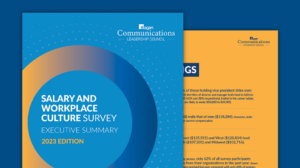Communications priorities for 2021 and beyond
Ragan’s Communications Leadership Council Benchmark Report reveals new areas of focus for communicators that add to more traditional concerns.

New priorities have emerged in the communications discipline this year, all of them related to the shocks of 2020. They include diversity, equity and inclusion, communicating with the remote workforce, workplace wellness and communications via mobile technology.
These 2021 priorities come in addition to traditional concerns like media relations, internal comms, crisis management, new technologies, and thought leadership. They’re in addition to honing brand journalism skills, and focusing on measurement.
These are among the key findings from Ragan’s third annual Communications Benchmark Report, an exclusive study from Ragan’s Communications Leadership Council. The Benchmark Report is based on responses to an online survey conducted between Jan. 13, 2021-Feb. 7, 2021. The survey yielded 755 qualified responses from internal and external communicators worldwide.
[EXECUTIVE SUMMARY: Communications Benchmark Report 2021]
The results paint a picture of a dynamic time, one where communications professionals have very much moved to center stage in an anything-but-typical year. Nearly 71% of respondents in the Benchmark Report indicated an increased focus on DE&I-related communications this year. “We need to be more outward spoken on social issues,” was a typical sentiment.
In addition to a new focus on DE&I, 53% of respondents said they’ve increased their focus on communicating with remote or non-desk workers, and 41% said they anticipate more communications via the mobile channel. Virtual communications, which is an effect of remote work, was a priority for 41%, while personalization was cited by 37%.
In the end, the survey clearly reveals a widespread consensus that a staggering number of changes are coming to the industry—in tech, in new channels and techniques, and in wellness and personalization—all led by DE&I and remote work.
But a common challenge in the DE&I realm is that organizations get caught talking the talk with no effective way to create real and lasting change. The Benchmark Report findings indicated that communicators are committed to that lasting change, and that their major DE&I priority is to engage in conversation. This applies both from the C-suite to the workforce, and also among workers themselves, through ERGs and other means.
Meanwhile, a significant subset of respondents, nearly 22%, did not increase DE&I activities last year. There were two primary reasons for this, respondents indicated. One was that at many organizations, DE&I policies were already in place. The other, cited less frequently, was that COVID became the 2020 communications priority and overwhelmed everything else. “We’ve been working to increase our DE&I efforts over the past four years, so there wasn’t a strong need for additional programming in 2020, though I do think we could be doing more,” was a typical response.
What changes do you expect to see in the communications industry in the next three-to-five years? (Respondents selected up to five.)
- Increased focus and investment on Diversity, Equity, and Inclusion – 63%
- Increased focus on communicating with remote or non-desk workers – 53%
- More communications via mobile – 41%
- Virtual communication – 41%
- More personalization – 37%
- Greater reliance on social media – 31%
- Workplace wellness – 26%
- Increased importance of employee advocacy – 26%
- More brand journalism storytelling – 23%
- Use of artificial intelligence – 23%
- More thought leadership – 20%
- More focus on influencer marketing – 16%
- Investment in Intranets will Increase – 10%
- Consolidation of communications under marketing – 8%
- Consolidation of communications under HR – 4%
- Decrease in number of PR firms – 4%
- Increase in number of PR firms – 3%
- Investment in intranets will decrease – 3%
- Other (please specify) – 1%
Which of the following best describes how you increased your DE&I initiatives in 2020? (Respondents selected all that apply.)
- Held open conversations within the organization (e.g., town halls, CEO chats) – 72%
- Developed organizational strategic plan on DE&I – 56%
- Unconscious bias/anti-racist training for employees – 50%
- Brought in outside speakers – 44%
- Created and/or expanded the number of employee resource groups (ERGs) – 36%
- Created new position to lead DE&I efforts – 36%
- Changed talent, retention and advancement policies – 35%
- Increased supplier/vendor diversity – 18%
- Launched DE&I ambassador program – 18%
- Other – 13%
Check out the full Benchmark Report here.







Today’s managements ask communicators what more should we say about DE&I and more but management’s question that could come with increasing urgency this year and next is what should our company DO to be saved?
When the market goes down and unemployment goes up, government policies will help decide which companies must pay more and which will profit less if at all. Each company’s fate may depend partly on how well communicators can present the company as a public asset, not a public liability.
A company creates jobs but it also creates pollution so how much jobs-creation is necessary and how much pollution is too much? Government subsidies will be called for to stimulate manufacture of electric cars, solar electricity and education but should corporate and individual taxes be raised to help ALL education including majors in Theater, Volleyball, Ancient History and English Literature?
What good is your company? That question may decide as it should whether your company gets a seat in a government lifeboat or is thrown to the sharks. What’s your company’s “social income”—contribution to the public—and “social rent” or cost to the public? Over 100 million Americans might be upset all day at seeing a cat run over on the road but not be upset for more than a few minutes at reading that our government has ended the life of a bank or drug company or one that collects and sells information on our preferences.
Judge whether it could hugely benefit the company and the public to have a Google Research Institute Against Cancer. Would even one politician in FIFTY thereafter rise in congress or on TV to urge that Google’s income from selling information should be cut by over a billion a year?
How about a Clorox Cleanliness Bureau to research how supermarkets and homemakers may even better protect us from germs that kill? Or a Ford Highway Safety Board to try saving 25,000 American lives a year?
When top management looks to communicators with increasing concern and even fear caused by rumblings in Washington, $1,000+ an hour PR savants may counsel that it’s not so much what we communicate that’s protective but how we help the public.
Money-making wisdom learned from PR Daily publications, courses and groups is that success springs not just from what we say but what we DO for the public. The Bible said it first (and for less than $1,000+ an hour) in counsel on what to DO unto others.